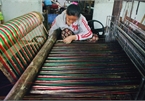From 1890 to 1945, Cu Da Village became the area's commercial centre. Many large houses with intricate carvings were built. There are also many houses built with western architecture or the mix of the east and west.
Cu Da Village is previously known as Ngo Khe Village, in Ha Thanh Oai Commune. The remaining old houses are varied. Some have three rooms while others have five rooms. The village has three main gates and the formation of the village looks like a fishbone. There are one main road and dozens of alleyways leading to 12 clusters. Each cluster has its own entrance gate with a couplet.
Pagodas or temples in the village are all national heritages. The villagers also still keep many traditional practices. In 1929, a villager donated money to build a flag pole for the village and since then, many important ceremonies have been held there.
The village is also famous for its soy sauce and vermicelli made from galangal powder. Thanks to technology and new machines, the production process has become easier.
However, many old houses in the village have deteriorated and in bad shape. Many have been replaced by modern houses. Even the gates to the clusters have also deteriorated.
Some photos of the village:

A house built in 1929







Dtinews

My Nghiep ancient weaving village in Ninh Thuan
As the cradle of brocade weaving of the Cham ethnic people, My Nghiep craft village is currently one of the two most famous traditional craft villages of Ninh Thuan Province.

Ancient village in Tien Giang province woes visitors
Dong Hoa Hiep village in Tien Giang province’s Cai Be district is home to many beautiful ancient houses that have contributed to the unique landscape of the Mekong delta.
 Cu Da Village in Hanoi is known for its many old houses and pagodas built in the 17th century but many of the houses in the village are deteriorating.
Cu Da Village in Hanoi is known for its many old houses and pagodas built in the 17th century but many of the houses in the village are deteriorating.